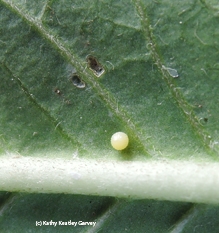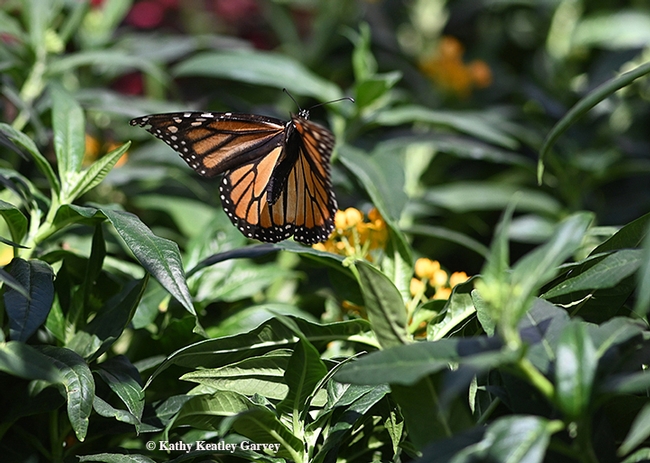What are the odds?
Here you are, standing in the garden section of a home improvement store, and you select a tropical milkweed to purchase. You place it on the ground and admire the brilliant yellow blossoms and luxurious green foliage. It's the best of the best. Just as you're about to pick it up and place it in a cart, a monarch lands on it and begins laying eggs.
What are the odds?
That happened to us around Wednesday noon, Sept. 4 in Vacaville as we were purchasing an end-of-the-season Asclepias curassavica.
Most likely, the plant had been in the nursery since last spring, as it was root-bound. We took it home, replanted it in a larger pot, and set it in the sun. Milkweeds like full sun. And monarchs go where their host plant is, whether it be in the wild, in your backyard, in your city park, or in a garden section of your local home improvement store.
Hopefully, the monarch eggs will hatch and this tropical milkweed will yield some caterpillars, chrysalids and adults.

Ironically, we found a monarch laying eggs in the garden section of a home improvement store!
Said entomologist David James of Washington State University, Pullman, who researches migratory monarchs: "That's an amazing story...selecting your milkweed and then having a female come over and deposit a few eggs for you!"
As an aside, as we were purchasing the milkweed, I casually asked the clerk at the check-out line "Have you seen any monarchs here?"
"Not in HERE," she said, surprised I would ask such a question. She tallied up the sale as "Mama Monarch" fluttered around her nursery, unnoticed, laying the next generation.
Curiously enough, a family member recorded a monarch laying eggs in the garden section of that same store the day before. About the same time. Maybe the same monarch. (See YouTube video)
Butterfly guru Art Shapiro, UC Davis distinguished professor of evolution and ecology, who has monitored all butterfly populations in the central valley for more than four decades and publishes his research on a website, says that “this is the biggest milkweed year in northern and central California in living memory. Speciosa is up to 5' tall and some fascicularis almost as big, and both are covered with both genera of Lygaeids (milkweed bugs), plus both oleander and gray aphids. But Monarchs only showed up here about two weeks ago! Lots of milkweed, no Monarchs to use it. I have seen 10 Monarchs in 2019 and have not seen a wild larva since 2017, and I am afield 260 days a year.”
Sometimes life just isn't fair. Entomologist Lynn Kimsey, director of the Bohart Museum of Entomology and professor of entomology at UC Davis, commented “Weirder and weirder. They still haven't found MY milkweed.”
Attached Images:
